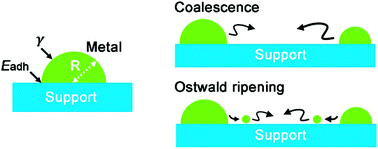当前位置:
X-MOL 学术
›
Chem. Soc. Rev.
›
论文详情
Our official English website, www.x-mol.net, welcomes your
feedback! (Note: you will need to create a separate account there.)
The physical chemistry and materials science behind sinter-resistant catalysts
Chemical Society Reviews ( IF 40.4 ) Pub Date : 2018-05-10 00:00:00 , DOI: 10.1039/c7cs00650k Yunqian Dai 1, 2, 3, 4 , Ping Lu 5, 6, 7, 8 , Zhenming Cao 5, 6, 7, 8 , Charles T. Campbell 8, 9, 10, 11 , Younan Xia 5, 6, 7, 8, 12
Chemical Society Reviews ( IF 40.4 ) Pub Date : 2018-05-10 00:00:00 , DOI: 10.1039/c7cs00650k Yunqian Dai 1, 2, 3, 4 , Ping Lu 5, 6, 7, 8 , Zhenming Cao 5, 6, 7, 8 , Charles T. Campbell 8, 9, 10, 11 , Younan Xia 5, 6, 7, 8, 12
Affiliation

|
Catalyst sintering, a main cause of the loss of catalytic activity and/or selectivity at high reaction temperatures, is a major concern and grand challenge in the general area of heterogeneous catalysis. Although all heterogeneous catalysts are inevitably subjected to sintering during their operation, the immediate and drastic consequences can be mitigated by carefully engineering the catalytic particles and their interactions with the supports. In this tutorial review, we highlight recent progress in understanding the physical chemistry and materials science involved in sintering, including the discussion of advanced techniques, such as in situ microscopy and spectroscopy, for investigating the sintering process and its rate. We also discuss strategies for the design and rational fabrication of sinter-resistant catalysts. Finally, we showcase recent success in improving the thermal stability and thus sinter resistance of supported catalytic systems.
中文翻译:

耐烧结催化剂背后的物理化学和材料科学
催化剂烧结是在高反应温度下失去催化活性和/或选择性的主要原因,是在多相催化的一般领域中的主要关注和巨大挑战。尽管所有非均相催化剂在操作过程中不可避免地要进行烧结,但通过精心设计催化颗粒及其与载体的相互作用,可以减轻直接和剧烈的后果。在本教程的回顾中,我们重点介绍了在理解烧结涉及的物理化学和材料科学方面的最新进展,包括对先进技术(例如原位)的讨论。显微镜和光谱学,用于研究烧结过程及其速率。我们还将讨论抗烧结催化剂设计和合理制造的策略。最后,我们展示了最近在改善负载型催化体系的热稳定性和耐烧结性方面取得的成功。
更新日期:2018-05-10
中文翻译:

耐烧结催化剂背后的物理化学和材料科学
催化剂烧结是在高反应温度下失去催化活性和/或选择性的主要原因,是在多相催化的一般领域中的主要关注和巨大挑战。尽管所有非均相催化剂在操作过程中不可避免地要进行烧结,但通过精心设计催化颗粒及其与载体的相互作用,可以减轻直接和剧烈的后果。在本教程的回顾中,我们重点介绍了在理解烧结涉及的物理化学和材料科学方面的最新进展,包括对先进技术(例如原位)的讨论。显微镜和光谱学,用于研究烧结过程及其速率。我们还将讨论抗烧结催化剂设计和合理制造的策略。最后,我们展示了最近在改善负载型催化体系的热稳定性和耐烧结性方面取得的成功。











































 京公网安备 11010802027423号
京公网安备 11010802027423号